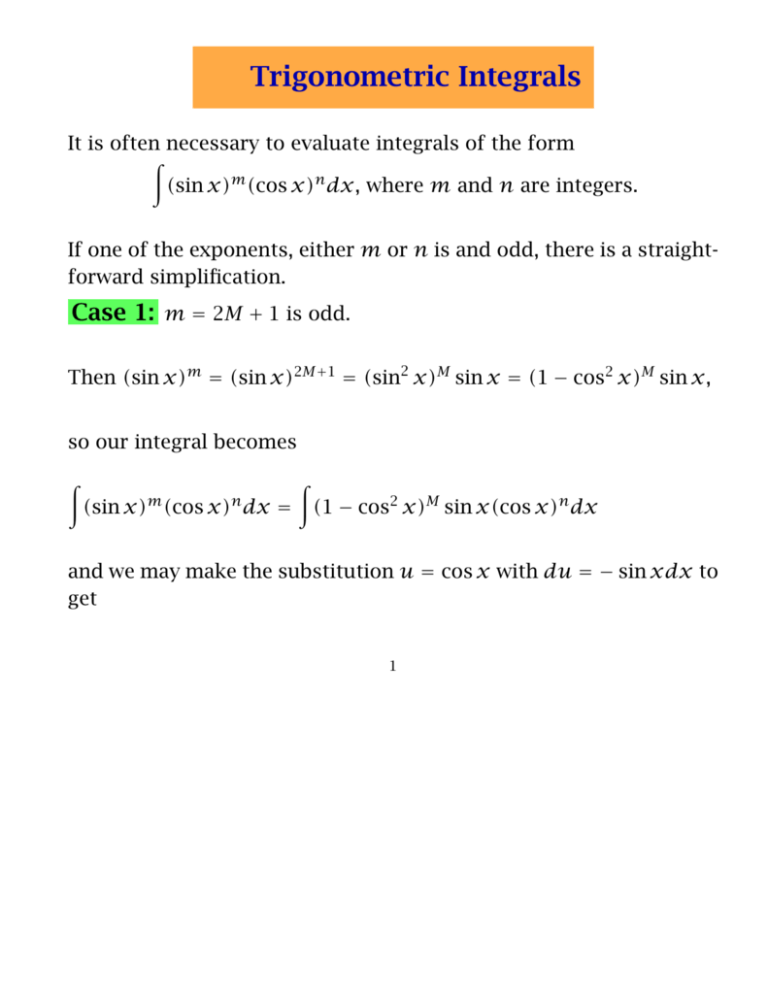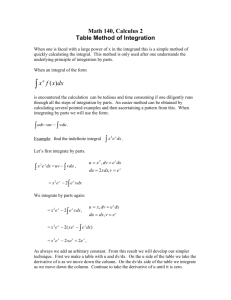Trigonometric Integrals
advertisement

Trigonometric Integrals It is often necessary to evaluate integrals of the form (sin x)m (cos x)n dx, where m and n are integers. If one of the exponents, either m or n is and odd, there is a straightforward simplification. Case 1: m = 2M + 1 is odd. Then (sin x)m = (sin x)2M+1 = (sin2 x)M sin x = (1 − cos2 x)M sin x, so our integral becomes (sin x)m (cos x)n dx = (1 − cos2 x)M sin x(cos x)n dx and we may make the substitution u = cos x with du = − sin xdx to get 1 (sin x)m (cos x)n dx = (1 − cos2 x)M sin x(cos x)n dx = − (1 − u2 )M un du Example: − (sin x)11 (cos x)10 dx = − (1 − u2 )5 u10 du = 2 2 2 2 3 2 4 2 5 1 − 5u + 10(u ) − 10(u ) + 5(u ) − (u ) − − u10 du = u10 − 5u12 + 10u14 − 10u16 + 5u18 − u20 du = 11 13 15 17 19 21 u u u u u u −5 + 10 − 10 +5 − 11 13 15 17 19 21 +C = cos11 x 5 cos13 x 2 cos15 x 10 cos17 x 5 cos 19x cos21 x + − + − + +C − 11 13 5 17 19 21 2 Example: − (sin x)11 (cos x)−10 dx = − (1 − u2 )5 u−10 du = 2 2 2 2 3 2 4 2 5 1 − 5u + 10(u ) − 10(u ) + 5(u ) − (u ) − u−10 du = u−10 − 5u−8 + 10u−6 − 10u−4 + 5u−2 − u0 du = − −9 −7 −5 −3 −1 u u u u u −5 + 10 − 10 +5 −u +C = −9 −7 −5 −3 −1 − − C= −9 7 −3 10 cos cos x 5 cos x + − 2 cos−5 x + 9 7 3 x − 5 cos−1 x − cos x + 5 10 1 sec9 x − sec7 x + 2sec5 x − sec3 x + 5secx + cos x + C 9 7 3 3 Example: (sin x)−11(cos x)−10dx = (sin x)−12(cos x)−10 sin xdx = − (1 − u2 )−6 u−10 du can be done, but requires the method of Partial Fractions, which we shall see later. The situation is similar when the power of cos x is odd. Example: (sin x)10 (cos x)11 dx = (sin x)10 (cos x)10 cos xdx = (sin x)10 (cos2 x)5 cos xdx = (sin x)10 (1 − sin2 x)5 cos xdx = ( letting u = sin x and du = cos xdx) 10 2 5 u (1−u ) du = 10 u 2 2 2 2 3 2 4 2 5 1 − 5u + 10(u ) − 10(u ) + 5(u ) − (u ) u10 − 5u12 + 10u14 − 10u16 + 5u18 − u20 du = 4 u11 u13 u15 u17 u19 u21 −5 + 10 − 10 +5 − +C = 11 13 15 17 19 21 5 2 10 5 1 1 sin11 x − sin13 x + sin15 x − sin17 x + sin19 − sin21 x + C 11 13 5 17 19 21 5 When both powers are odd, it is easiest to select the function with the highest power for substitution: Good Example: (sin x)11 (cos x)3 dx = (sin x)11 (cos x)2 cos xdx = (sin x)11 (1 − sin2 x) cos xdx = ( letting u = sin x and du = cos xdx) 11 2 u (1 − u )du = u 11 u11 u14 − u du = − +C = 11 14 13 1 1 sin11 x − sin13 x + C 11 14 6 Bad Example: (sin x)11 (cos x)3 dx = (sin x)10 (cos x)3 sin xdx = (1 − cos2 x)5 (cos x)3 sin xdx = ( letting u = cos x and du = − sin xdx) (1 − u2 )5 u3 (−du) = 2 2 2 2 3 2 4 2 5 −1 + 5u − 10(u ) + 10(u ) − 5(u ) + (u ) u3 du = 3 5 7 9 −u + 5u − 10u + 10u − 5u 11 +u 13 du = u6 u8 u10 u12 u14 u4 +5 − 10 + 10 −5 + +C = − 4 6 8 10 12 14 5 5 5 1 1 cos12 x + cos14 x + C − cos4 x + cos6 x − cos8 x + cos10 x − 4 6 4 12 14 7 When neither power is odd, we need to use a double angle formula from trigonometry: cos 2x ≡ 2 cos2 x − 1 = 1 − 2 sin2 x can be solved for cos2 x and sin2 x: 1 + cos 2x 1 − cos 2x cos2 x = and sin2 x = 2 2 Thus, if we want to integrate (sin x)m (cos x)n dx, where m and n are even integers, we write m = 2M and n = 2N and we have: (sin x)m (cos x)n dx = (sin x)2M (cos x)2N dx = (sin2 x) (cos2 x)N dx 1 − cos 2x M 1 + cos 2x N dx = 2 2 M N −(M+N) 2 (1 − cos 2x) (1 + cos 2x) dx 8 M 1 + cos 2x dx = 2 1 1 1 1 + cos 2xdx = x + sin 2x + C = 2 2 2 Example: cos2 xdx = x 1 x + sin x cos x x 1 + sin 2x + C = + 2 sin x cos x + C = +C 2 4 2 4 2 1 − cos 2x dx = 2 1 1 1 1 − cos 2xdx = x − sin 2x + C = 2 2 2 Example: 2 sin xdx = x 1 x − sin x cos x x 1 − sin 2x + C = − 2 sin x cos x + C = +C 2 4 2 4 2 It should come as no surprise that 9 2 2 cos x + sin x dx = x + C Example: sin2 x cos2 xdx = 1 − cos 2x 2 1 + cos 2x dx = 2 1 1 + cos 4x 1 1 1 − cos2 2xdx = 1− dx = 1 − cos 4xdx = 4 4 2 8 1 1 x sin 4x x − sin 4x + C = − +C 8 4 8 32 10 Products of powers of secant and tangent functions secm x tann x can be expressed as a product of powers of sin x and cos x, but it is often more convenient to use the identity tan2 x + 1 = sec2 x and the differentials d(tan x) = sec2 xdx and d(secx) = secx tan xdx. We assume that m and n are non-negative. Case 1: The power m of secx is positive and even: then m = 2M and we have: secm x tann xdx = (sec2 x)M tann xdx = n (sec2 x)M−1 t xsec2 xdx = (1 + tan2 x)M−1 tann xsec2 xdx = and we can make the substitution u = tan x, du = sec2 xdx, and we get M−1 M−1 2 n 2 2 1 + tan x tan xsec xdx = 1+u un du 11 Example: 10 5 sec x tan xdx = 1+u 1 + 4u2 + 6u4 + 4u6 + u8 u5 du = 2 4 u5 du = u5 + 4u7 + 6u9 + 4u11 + u13 du = u8 u10 u12 u14 u6 +4 +6 +4 + +C = 6 8 10 12 14 1 14 1 6 1 8 3 10 1 12 u + u + u + u + u +C = 6 2 5 3 14 1 3 1 1 1 tan6 x + tan8 x + tan10 x + tan12 x + tan14 x + C 6 2 5 3 14 12 If the power of secx is not even, but the power of n of tan x is odd, so that n = 2N + 1, and m is positive, we can make the substitution u = secx, du = secx tan xdx, and get secm x tann xdx = secm−1 x tan2n xsecx tan xdx = N N m−1 2 m−1 2 u tan x du = u sec x − 1 du = u m−1 N 2 u −1 Example: du 5 5 sec x tan xdx = 4 2 2 u (u − 1) du = 1)du = u9 u7 u5 8 6 4 −2 + +C = u − 2u + u du 9 7 5 2 1 1 sec9 x − sec7 x + sec5 x + C 9 7 5 13 u4 (u4 − 2u2 + We are left with the cases where m is odd and n is even, all of which can be reduced to the problem of finding the antiderivative of an odd power of secx. secx + tan x dx = Example: secxdx = secx secx + tan x (sec2 x + secx tan x)dx sec2 x + secx tan x dx = = secx + tan x secx + tan x d(secx + tan x) = ln(secx + tan x) + C secx + tan x 14 Example: I = sec3 xdx Using Integration by Parts, with u = secx, dv = sec2 x, v = tan x, du = secx tan xdx, we get I= sec3 xdx = udv = uv − vdu = secx tan x − tan xsecx tan xdx = secx tan x − tan2 xsecxdx = secx tan x − (sec2 x − 1)secxdx = secx tan x − sec3 xdx + secxdx = secx tan x − I + secx tan x + ln |secx + tan x| + C so 2I = secx tan x + ln |secx + tan x| + C and sec3 xdx = secx tan x + ln |secx + tan x| +C 2 15 secxdx = Example: tan2 xsecxdx appears in the previous calculation, and is one of the simpler cases left: I = secx tan x − tan2 xsecxdx gives us tan2 xsecxdx = secx tan x − I = secx tan x − secx tan x + ln |secx + tan x| +C = 2 secx tan x − ln |secx + tan x| +C 2 16 Integrals of products of sine and cosine functions with different arguments The identities: cos x cos y = 1 cos(x + y) + cos(x − y) 2 1 cos(x − y) − cos(x + y) sin x sin y = 2 1 sin(x − y) + sin(x + y) may be used: 2 1 Example: cos 5t cos 7tdt = (cos(5t + 7t) + cos(5t − 7t)) dt = 2 1 1 1 1 sin 12t + sin 2t + C = (cos 12t + cos(−2t)) dt = 2 2 12 2 sin x cos y = 1 1 sin 12t + sin 2t + C 24 4 17






